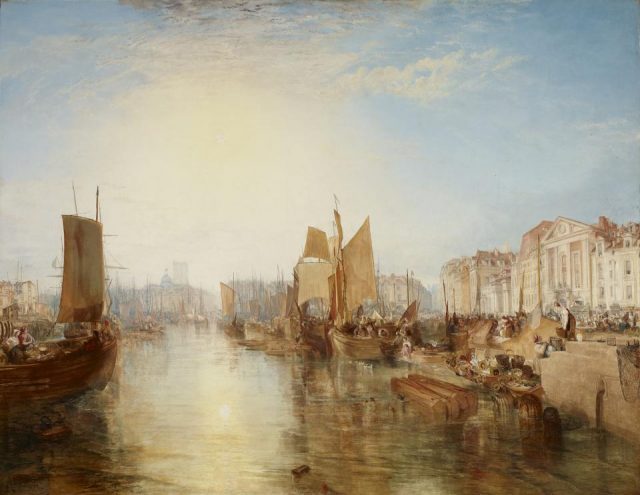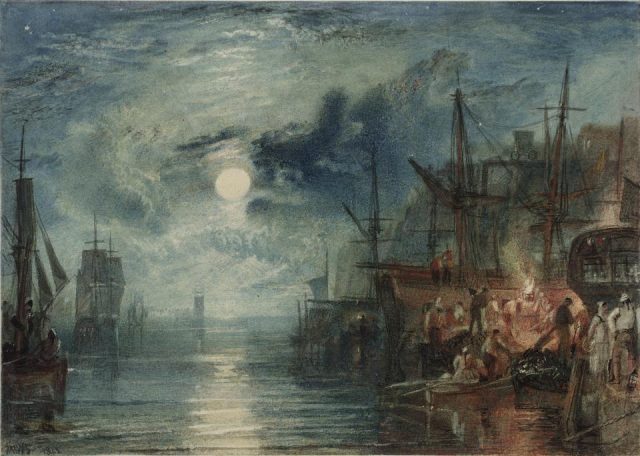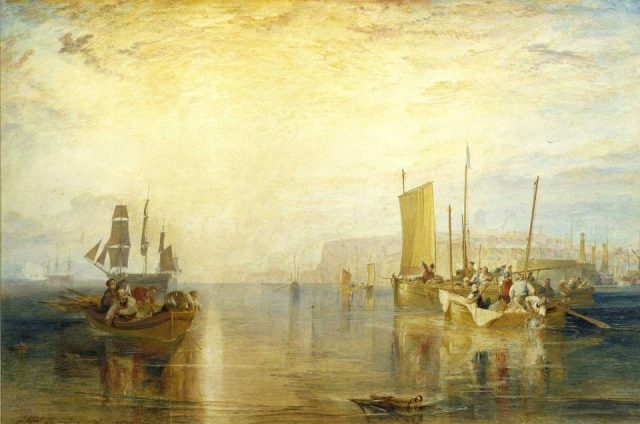
Joseph Mallord William Turner, “The Harbor of Dieppe: Changement de Domicile,” oil on canvas, exhibited 1825 but subsequently dated 1826 (© The Frick Collection)
The Frick Collection
1 East 70th St. at Fifth Ave.
Through May 14, $12-$22 (pay-what-you-wish Sundays 11:00 – 1:00)
212-288-0700
www.frick.org
There’s less than a week left to see the Frick’s splendid exhibition “Turner’s Modern and Ancient Ports: Passages through Time,” a two-part show that continues through May 14. The exhibit expands on two of the Frick’s finest monumental works by Joseph Mallord William Turner, “The Harbor of Dieppe: Changement de Domicile” from 1825 and “Cologne, the Arrival of a Packet-Boat: Evening” from 1826, which have been moved from the West Gallery into the Oval Room, where they are joined by four other lovely canvases, three from the Tate and one from the Met, all depicting port scenes. In her exhibition catalog essay “Liminal Spaces: Turner’s Paintings of Dieppe and Cologne,” Frick senior curator Susan Grace Galassi writes of “Dieppe,” “Cologne,” and “The Harbor of Brest: The Quayside and Château,” which is also in the Oval Room, “This trio of grand-scale paintings of the mid-1820s, which follow from ‘Dort or Dordrecht: The Dort Packet-Boat from Rotterdam Becalmed’ exhibited in 1818, attests to the significance of the port in Turner’s work during the decade after the Continent had been newly reopened to British travelers at the end of the Napoleonic Wars in 1815. Sea and river ports, whether of the present or past, exerted a powerful hold on Turner’s imagination as transitional spaces of arrival and departure, and as a country’s or city’s welcoming gateways or defensive barriers. While Turner drew upon various models of the past for his port scenes, he departed daringly from naturalism through his use of high-keyed color and effects of transparency and luminosity, provoking criticism and controversy when the works were first exhibited.”

Joseph Mallord William Turner, “Shields, on the River Tyne,” watercolor on paper, 1823 (© Tate, London 2016)
Seen together, the works are majestic in both skill and scope, with the golden light of the sun forging entrancing passageways that emanate from the paintings’ vanishing point until the glow seemingly permeates the room. Boats, logs, buildings, and people are brilliantly reflected in the shimmering water as everyday life goes on. Each work has its unique charms and special details, from the dog nipping at the water in “Cologne, the Arrival of a Packet-Boat: Evening” to the men and women huddled on the side of the mountain in the unfinished “The Harbor of Brest: The Quayside and Château” (which harkens to Turner’s later, abstract canvases), from the daytime moon in “Ancient Rome; Agrippina Landing with the Ashes of Germanicus. The Triumphal Bridge and Palace of the Caesars Restored” to the shadow of a statue in “Ancient Italy — Ovid Banished from Rome.” And in “Regulus,” Turner takes a wicked shot at his critics, who had complained of the “blinding” nature of his use of light, here depicting Roman general Marcus Atilius Regulus — he is not actually very easy to spot in the right side of the painting — who was blinded by the Carthaginians in a particularly nasty way: They either cut off his eyelids or sewed his eyes open, then forced him to stare into the sun as he was tortured to death. Turner’s revenge on his naysayers was to make them stare into the sun in his painting, although it is, of course, far from torturous to do so.

Joseph Mallord William Turner, “Sun-Rise: Whiting Fishing at Margate,” watercolor on paper, 1822 (private collection)
Working primarily from sketches, memory, and imagination, Turner also took advantage of the lifting of European travel bans, venturing to France and Germany in addition to various locations in England and Wales, making wonderful watercolors, more than two dozen of which line the Frick’s East Gallery, along with several prints. The seascapes include the rare vertical “On the Upper Rhine,” in which lumber is being transported on a rickety raft making its way through a narrow gorge; “Shields, on the River Tyne,” with the moon casting its glow on coal workers toiling away on a cargo ship; “Cologne: Colour Study,” in which Turner’s brushstrokes are clearly evident; and “Devonport and Dockyard, Devonshire,” with swirling clouds giving way to the sun as well-dressed women and soldiers rowing toward the shore at the end of the Napoleonic Wars. Be sure to grab a magnifying glass to catch every exquisite detail. Making my way through the exhibit, I couldn’t help but think of Timothy Spall portraying the artist in the 2014 film Mr. Turner, the grunting iconoclast heading to his favorite seaside town where he would paint water scenes. If you can’t make it to the Frick, then you must check out its fantastic virtual exhibition, a 360-degree tour of the Oval Room and the East Gallery, featuring zooms as well as links to every piece in the show, with wall text and enlarged images of these illustrious works, which celebrate the natural world while also referencing the rise and fall of civilization. “Turner has some golden visions, glorious and beautiful,” rival artist John Constable said after attending the 1828 Royal Academy Exhibition. “They are only visions, but still, they are art, and one could live and die with such pictures.”